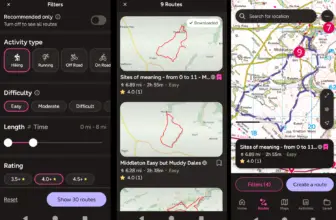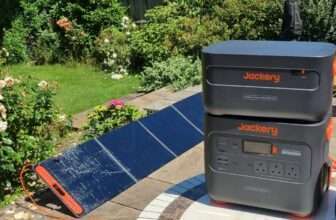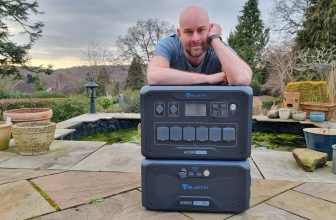Bluetti AC180 Review – Is this the Perfect-Sized Power Pack?
Alot of people have been hollering for Bluetti to release the AC180, and there’s talk of it being the ‘Perfect Power Station’. We put that idea to the test……
What we like about the Bluetti AC180: Can flex output power; Great size; Rugged build; Wireless charge pad; 1800W output is lovely; Great App
What we don’t like about the Bluetti AC180: Only 1 x USB-C and 2 x AC outputs; Can’t expand battery
Roughing it in the wild is all fun and games until your phone dies and you realize you’re lost in the woods. Okay, maybe that’s a bit dramatic, but having reliable power while camping is crucial these days to keep your devices charged and appliances running. That’s where portable power stations come to the rescue.
When it comes to capacity, it’s our view that 1000Wh is really the sweet spot for most weekend campers. It’s enough juice to keep the party going and keep you feeling civilized with your gadgets without being overly bulky and heavy. Of course, power hungry users might need 2000Wh or serious off-grid folks might want solar arrays and 10,000Wh setups. But for us regular weekend warriors, 1000Wh lets you see the sights during the day and have some creature comforts at night.
Enter the Bluetti AC180, a new compact lithium battery pack rated at 1152Wh. We’ve used the AC180 on several camping trips over the past few months to put it through its paces. How did it hold up to real-world use?
Read on for our full review of this pint-sized yet powerful portable power station.
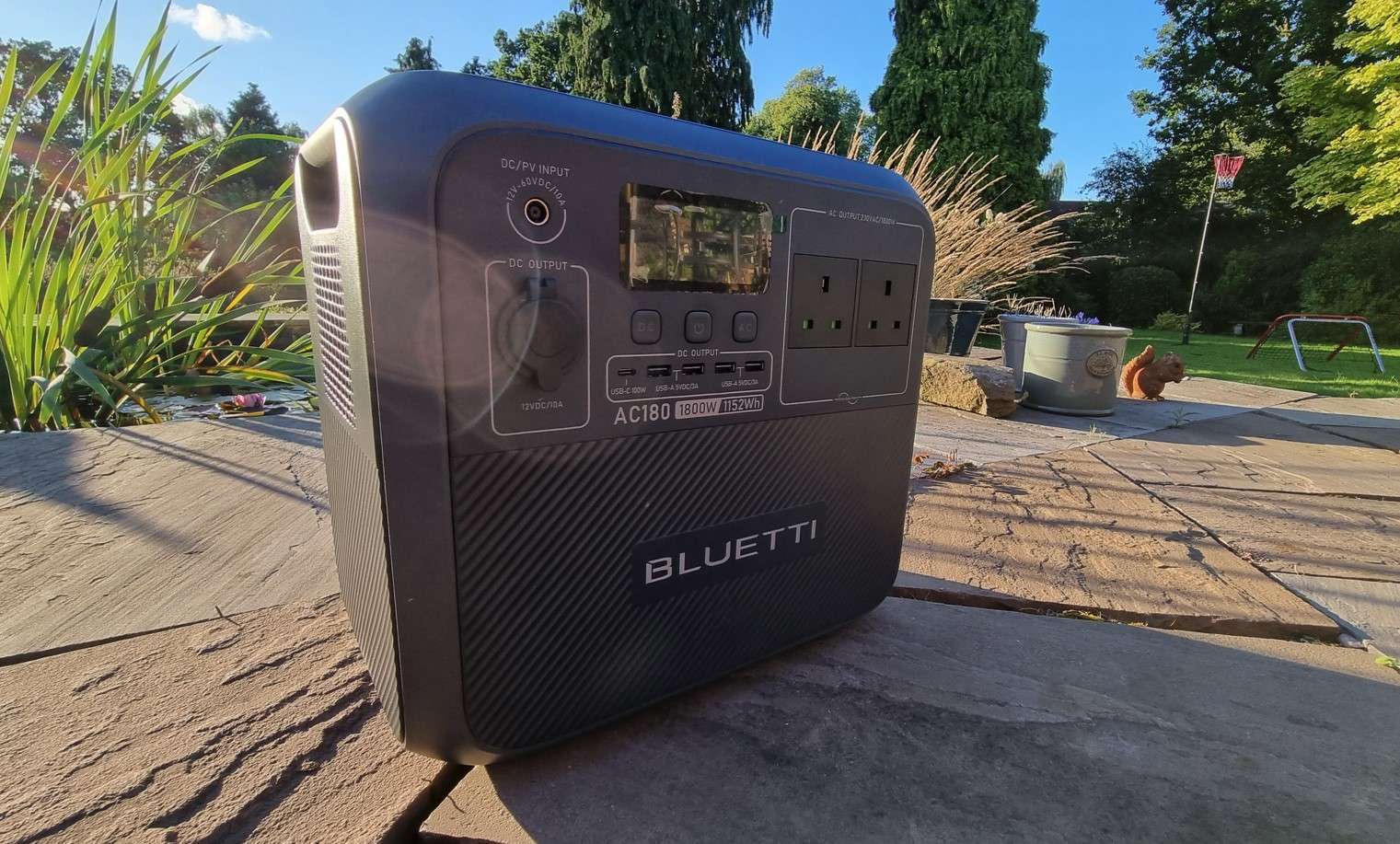
Contents
ToggleBluetti AC180: What’s In The Box?
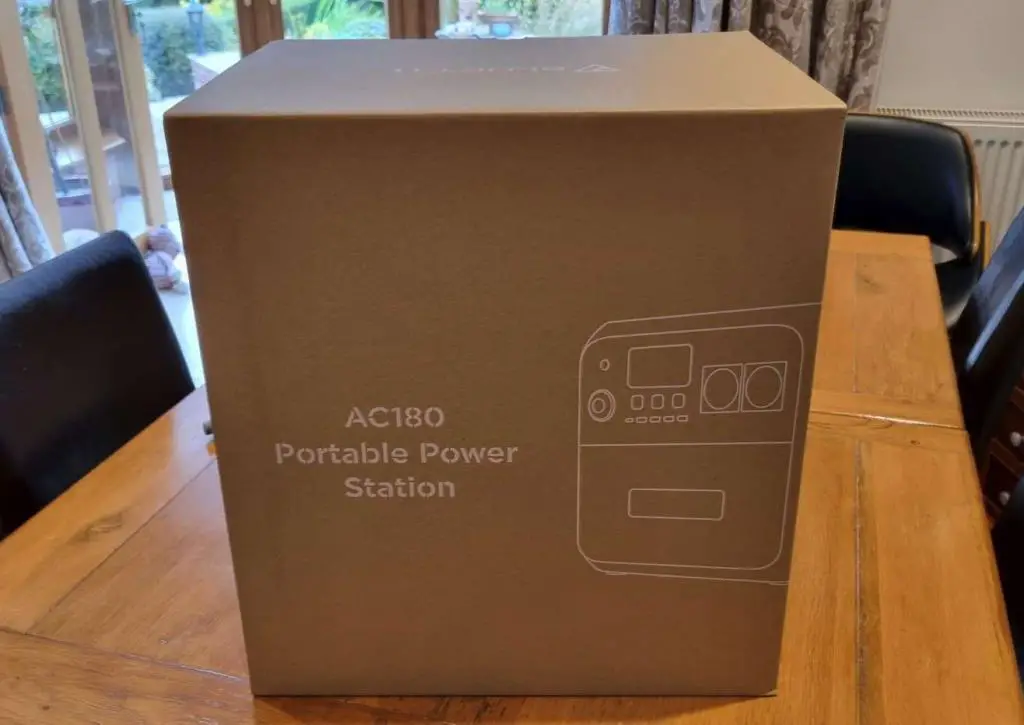 The Bluetti AC180 comes packaged with several handy accessories for powering your devices on the go:
The Bluetti AC180 comes packaged with several handy accessories for powering your devices on the go:
- AC charging cable allows you to recharge the AC180 by plugging into a wall outlet at home or a powered campsite. Fully replenishes the power station in around 1-2 hours.
- Car charging cable – Recharges the AC180 through your vehicle’s 12V outlet while driving. Great for topping it off during road trips to your campsite.
- Solar charging cable – Connect solar panels (sold separately) to the AC180 for renewable charging while off the grid. Makes the station fully sustainable for wild camping scenarios.
- User manual – Includes operating instructions, charging guidelines, and technical specs. Useful for learning the ins and outs of the power station.
Quick start guide – A handy reference card for basic operation. Reassuring to have the basics at your fingertips. - 5-year warranty card – Bluetti provides an industry-leading 5-year warranty on the AC180 for peace of mind. Longer than most competitors.
The included components provide multiple charging options and documentation for getting started with the AC180 power station. No need to purchase additional accessories for basic operation during camping adventures.
Bluetti AC180: Dimensions and Weight
The Bluetti AC180 measures 34 x 24.7 x 31.7 cm (13.4 x 9.7 x 12.5 inches), making it a fairly compact portable power station. It has integrated handles on the top which makes it easy to lift and move around.
The total weight is 16 kg (35.3 lbs), which is on the heavier side for the capacity on offer, and this is partly due to the lithium iron phosphate (LiFePO4) battery chemistry used in the AC180. While not as energy dense as lithium nickel manganese cobalt oxide (NMC) batteries, LFP batteries offer increased longevity and safety. The tradeoff is less storage capacity per kg compared to NMC designs. However, LFP batteries can withstand many more charge/discharge cycles before degrading. Bluetti rates the AC180 at 3500+ cycles to 80% original capacity.
So while the AC180 may weigh more than NMC competitors, this is balanced by the long-term resilience of LFP chemistry. The size and weight may be worthwhile for users prioritizing battery life over marginal portability gains. And the integrated handles help maneuverability during transport.
Bluetti AC180: Key Features
Charging the AC180
The AC180 can charge rapidly using its maximum 1440W AC input. In my testing, it was able to charge from 0% to 100% in just over 1 hour when using the Turbo charging mode. The power ramped up quickly to 1400W and remained there for most of the charge cycle before tapering off towards the end to protect the battery.
Using the Turbo mode, the AC180 hits over 1000W of input within the first minute. This allows it to take advantage of high power electrical hookups when available. The fan does come on during rapid charging, so it’s not completely silent, but the noise is reasonable.
For solar, the AC180 can accept up to 500W of input from solar panels. Recharge times will vary based on sunlight intensity and panel setup. Solar recharging from empty to full in ideal conditions takes around 3 hours.
The car-charging cable allows recharging from a vehicle’s 12V outlet while driving. This is a slower 100W input, so a full recharge takes over 12 hours. Still, it helps top up the AC180 during road trips to your campsite.
The AC180 allows simultaneous charging and discharging, and we tested this successfully with a solar panel attached to the DC input on the front. With the rapid AC or solar charging options, the AC180 can be powered up conveniently in timescales reasonable for weekend camping trips.
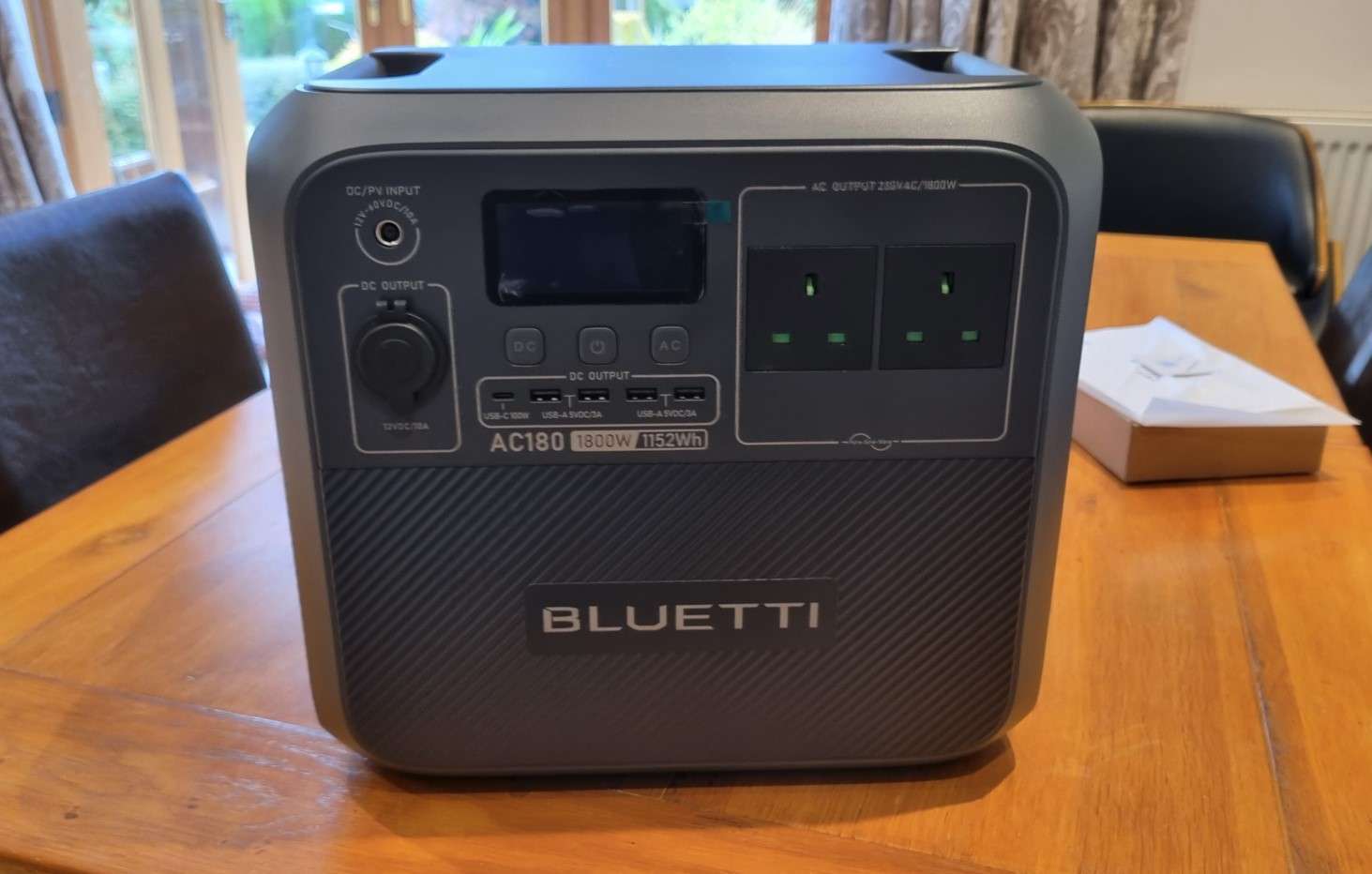
AC Output and Power Lifting
The AC180 has a pure sine wave inverter that delivers 1800W of continuous power output. This is enough to handle most common appliances you’ll use while camping or during a power outage. There are two AC outlets to plug devices into.
While 1800W is sufficient for smaller appliances, the AC180 also features a ‘power lifting’ mode. This allows it to temporarily provide up to 2700W of surge power for devices with high start-up current draws. So you can smoothly run equipment like electric kettles or toasters that briefly spike above 1800W when turned on.
It’s like having a portable generator that intelligently adjusts the voltage to match the appliance. I successfully tested power lifting with a 2400W electric kettle. Rather than overload and trip off, the AC180 delivered enough temporary power to start the kettle before settling at a lower wattage to operate safely within its limits.
The power lifting mode is really handy for using your existing AC appliances without having to buy special lower wattage versions just for your power station. It makes the AC180 flexible for powering a wide range of devices. You can enjoy small creature comforts of home while off-grid camping with this useful feature.
More AC180 Features – Display, App and Loads of Ports
In addition to its rapid charging and power-lifting capabilities, the AC180 offers several other valuable features.
The integrated display provides an easy-to-understand dashboard showing your remaining battery percentage, power draw, and estimated time remaining. It lets you monitor the AC180’s status at a glance without needing the smartphone app open. I found it very clear and easy to read, but a bit tricky to see clearly in the brightest sunshine.

Speaking of the app, it provides full monitoring and control of the AC180 via Bluetooth or WiFi. You can turn ports on/off, activate power lifting mode, and configure charging parameters. It’s a responsive and intuitive app that complements the power station well.
In terms of ports, the AC180 has 4 USB-A ports for charging mobile devices. There is also a 100W USB-C port capable of rapidly charging high-powered laptops, tablets, and even small appliances. Rounding out the outputs is a 12V car outlet for running things like portable fridges.
For recharging, the AC180 can accept solar input up to 500W in addition to AC and 12V car charging. The integrated wireless charging pad on the top is perfect for wirelessly juicing up your phone or earbuds without fussing with cables.
Additional perks include the lack of an external power brick, 5 year warranty, and advanced battery management system to monitor cell conditions. Overall, Bluetti hit all the key features you’d expect in a modern portable power station.
Testing and ‘In-Use’
When I got my hands on the Bluetti AC180 power station, I was eager to put it through its paces in various real-world scenarios.
Testing the Bluetti AC180 Without Power Lifting Mode:
Our testing begins with an exploration of the Bluetti AC180’s capabilities without activating the Power Lifting mode. Initially, we saw the startup sequence and a brief burst of fan noise upon activation. The inverter consumes 15 watts even before any external load is applied, which is a reasonable amount, and can hit efficiency when running low-power loads.
When we attempt to power a 3kW kettle without Power Lifting mode, the inverter tripped, and an overload alarm appeared. Despite our efforts to reset the inverter with an override switch, we had to restart the entire unit to restore functionality.
Activating Power Lifting Mode:
Before retesting the kettle, we explore the process of activating Power Lifting mode on the Bluetti AC180. By entering the settings mode on the front panel and holding down the AC button, we successfully activate Power Lifting mode, symbolized by a “muscle arm” icon on the screen.
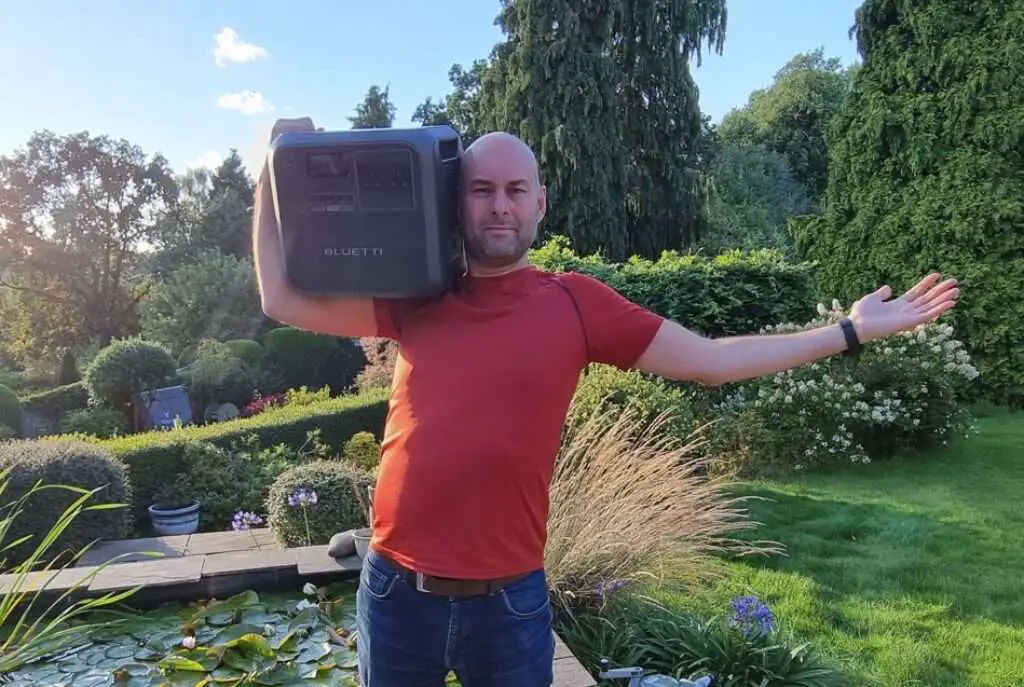
Testing the Bluetti AC180 with Power Lifting Mode:
Now equipped with Power Lifting mode, we reattempt to power the same 3kW kettle. To our surprise, the inverter no longer trips. Instead, it effectively limits the kettle’s power draw to just under 1700 Watts, essentially transforming it into a lower-wattage version. This feature is great because it means you can use a regular kettle for camping without having to buy a low-wattage alternative. Although it takes longer to boil water, the flexibility it offers is immense.
Additional High-Power Draw Testing:
Our evaluation extended to other appliances, such as a toaster. With Power Lifting mode, the Bluetti AC180 successfully powered both sides of the toaster while maintaining a manageable wattage level. Although the toasting process may take slightly longer, it aligns well with the relaxed pace often associated with camping.
In a similar way we conducted a hairdryer test to gauge the Bluetti AC180’s ability to handle a high-wattage appliance. As expected, the power station wasn’t able to provide the hairdryer’s full power output at its maximum setting. However, it did manage to deliver approximately 1400 Watts of power, indicating its adaptability in supplying power efficiently.
Bluetti AC180: Efficiency and Battery Drain:
During our tests, we observed some battery drain with the outputs enabled and no load attached. This raised questions about the power station’s overall efficiency. It’s essential to note that the Bluetti AC180 incorporates a depth-of-discharge feature, which means that even when the battery indicator reads 0%, there’s still about 10% of usable battery life left. This design choice is made to extend battery longevity. Additionally, the power station itself consumes approximately 15 watts for its operation, including running the fans and display.
When running a 50W cool box and taking the AC180 from 100% to 0%, we measured a total power drain of 810Wh out of the total of 1152Wh. That’s an efficiency of 70% which is fairly low. Running a higher power appliance increases the efficiency to ~80%.
Charging Time:
We measured the charging time of the Bluetti AC180 to assess its speed of replenishing its battery. In our test using the turbo charging mode, the power station fully charged from 0% to 100% in approximately one hour and five minutes. This charge time is very respectable for a power station with a capacity of around 1.1 kWh.
AC180 vs the Competition
In comparison to other power stations on the market, the Bluetti AC180 competes most directly with the EcoFlow Delta 2. While the Bluetti offers slightly cheaper pricing at the time of writing (£100 less), the Delta 2 boasts expandable capacity, additional AC sockets, and more USB-C ports. The efficiency and useable capacity of the Bluetti AC180 is also slightly lower than the Delta 2, although we have not done a direct head-to-head comparison of this with exactly the same conditions.
It’s also worth mentioning the size of the AC180. In the photo below we show it against the Jackery 2000 Pro which has double the capacity – they are effectively the same size. This is because the Jackery uses NMC batteries whereas the Bluetti uses LFP.

Conclusions
The Bluetti AC180 power station offers a robust and well-made solution for your portable power requirements.
Throughout our testing, we encountered no issues with unexpected shutdowns or rapid discharging. Several aspects of the power station stood out positively:
- No External Power Brick: The absence of an external power brick streamlines the setup and contributes to its modern design.
- Wireless Charging: Bluetti’s inclusion of wireless charging capability adds a unique and convenient feature.
- Handles: The well-designed handles make it manageable to lift and carry, even with a weight of 16 kilograms.
- Connectivity: The device offers a standard array of ports, including four USB-A ports, one USB-C port, and a user-friendly display.
- Power Lifting Mode: The power lifting mode is a notable feature, allowing the power station to accommodate high-power devices with resistive elements by adjusting voltage and current accordingly.
While the Bluetti AC180 does these things well, it should be emphasized that they have all been seen before on other power stations – there’s nothing which is revolutionary here. It just does it all well. The 70% efficiency is a bit of a concern though, and you will need to take this into account with your power planning.
Would we recommend the Bluetti AC180 power station? Yes, we would, under specific conditions. At its current price point of £999, it offers a competitive value proposition. However, it’s essential to consider your individual requirements and needs when choosing a power pack. For me, 1000Wh is the bear minimum for a weekend of camping – personally I feel more comfortable taking 2000Wh.
If you are in the market for a new power station and prioritize reliable performance, convenience, and a reasonable price, the Bluetti AC180 is a sound choice.
While offering nothing particularly groundbreaking and with an efficiency of 70-80%, the Bluetti AC180 does lots of things well in a nice compact package. The app and display are class-leading and it has worked flawlessly in our tests, especially the power-lifting mode. It's definitely worth a buy if you can get that low price point.
Frequently Asked Questions
- What sets the Bluetti AC180 apart from other portable power stations?
The Bluetti AC180 distinguishes itself with its exceptional AC efficiency, delivering close to its rated capacity. Unlike many other power stations that advertise their maximum capacity but fall short in real-world usage, the AC180’s high efficiency ensures you get close to the full 1,000 watt-hours (Wh) of capacity it claims. - What types of ports does the Bluetti AC180 offer?
The Bluetti AC180 provides four NEMA 6-20P AC sockets rated at 20 amps, offering versatile options for connecting household devices. It also features four USB-A ports, a USB-C port, a 12-volt “cigarette” power outlet, and multiple charging options, including AC, DC, and solar inputs. - Can I expand the Bluetti AC180’s battery capacity?
No it’s not expandable - What type of battery does the Bluetti AC180 use, and what is its lifespan?
The Bluetti AC180 uses lithium iron phosphate (LiFePO4) battery chemistry, known for its longevity. Bluetti rates the AC180 for over 3,500 full cycles before the battery capacity reaches 80%. This is significantly higher than many portable power stations using NMC lithium-ion cells, which typically offer only 500 to 800 cycles to reach 80% capacity. - How does the Bluetti AC180 perform in terms of efficiency?
We measured 70% efficiency under a 50W load and about 80% under a 500W load. - How loud is the Bluetti AC180 during operation?
While not completely silent, the Bluetti AC180 is reasonably quiet. It generates around 45 decibels (dB) under a 1,500-watt load and slightly less under an 800-watt load. The fans are quieter than some competing models. Importantly, the fans remain silent under 100 watts of load, suitable for powering devices like CPAP machines without disturbance. - What is the weight of the Bluetti AC180, and how does it compare to other power stations?
The Bluetti AC180 weighs 15.9 kilograms, making it one of the heavier units in its capacity range. It offers approximately 32.5 watt-hours (Wh) per kilogram. While it’s heavier, its high efficiency compensates by delivering more watt-hours per kilogram compared to some competitors. - Does the Bluetti AC180 have a mobile app for control?
Yes, the Bluetti AC180 offers both Wi-Fi and Bluetooth app support for both iOS and Android devices. The app provides comprehensive control over various settings, including charge rates, firmware updates, and power consumption monitoring. An offline Bluetooth mode is also available for use during power outages or when internet connectivity is limited. - What accessories come with the Bluetti AC180?
When you purchase the Bluetti AC180, it includes an AC charging cable, a car charging cable, and a solar charging cable, ensuring you have the essential accessories to get started. - Is the Bluetti AC180 a good value for its capacity?
The Bluetti AC180 offers good value for its capacity, especially given its premium brand reputation. Its initial debut price of £999 (though it has a list price of £1,099) equates to roughly 87p per watt-hour (Wh), making it competitively priced compared to other models in the market.





